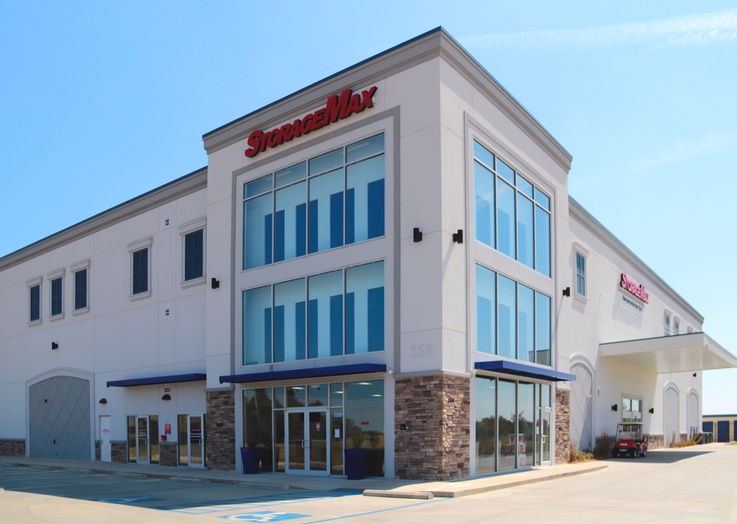Modern Makeovers
Rehabbing Older Facilities
Someone once said, “old places have soul”. They might have soul, but, if you are the owner of an older self-storage facility and you haven’t updated it in a while, chances are the sparkling new facility down the street might be bringing in more souls, and that translates into new business.
Renovating an older facility might be as easy as putting a fresh coat of paint on the doors or it might mean ripping that tired steel off the entire facility and giving it all a brand new updated look. Costs, however, might not be the only challenge you face. If you have a first- or second-generation facility, a lot of things have likely changed in your jurisdiction. Your city or town may have adopted new signage rules, you may have to update your facility to full ADA compliance, and you may not be able to choose your new colors without approval. There is also the conundrum of working around your existing tenants.
However, if you navigate it properly, the rewards can be great for renovating your facility. “Perception is reality,” says Bob Pouliot, principal, Boardwalk Storage Solutions in Mansfield, Mass. “If you can make your self-storage facility appear more modern and secure, you can sometimes raise your occupancy significantly.”
5A Upgrade
Michael J. Knuppe, president of 5A Rent-A-Space, saw firsthand how a major upgrade could help occupancy. The Foster City facility has 1,424 units and 141,240 square feet of rentable space. In 2012, the facility hovered at around 70 percent occupancy. The renovations have been done in phases; as each phase was completed, the occupancy continued to grow to 85 percent in 2015. In early 2017, the occupancy was at 93 percent.
Many second- and third-generation facilities might require fewer upgrades, but 5A Rent-A-Space in Foster City, Calif., is a first-generation facility, built in 1976. Although the facility has been through several upgrades, Knuppe claims it still needed a major facelift.
“We’ve had two or three remodels over the years,” says Knuppe. “Foster City sits on an island and is a bedroom community; and the city really held a lot of control over design criteria and colors.”
Knuppe’s properties have the advantage of being in great locations, so it’s very important that his facilities be in top shape. “We only have one chance to make a first impression,” says Knuppe. “We have a real basic philosophy; cleanliness is the essence of our business model.”
Three years ago, Knuppe and his company decided to embark on a $1.2 million upgrade to the facility. 5A Rent-A-Space in Foster City received a complete facelift, which gave it a more modern, brighter feel and brought the facility into 21st century with solar energy technology.
The upgrade to solar resulted in almost immediate cost savings as well. The facility is producing 90 percent of its own energy. “We really believe in solar power,” Knuppe says. The company had already converted its Hawaiian location to solar, which is generating all of its own energy and selling back the extra it generates to the local utility.
For the Foster City facility, 65 percent of the installation costs of the solar system was paid for with federal and state income tax incentives and rebates. Utility bills decreased from $1,200 per month to $60. And the whole system will be paid off in five years from energy savings.
Generating artificial light wasn’t the only consideration, windows were added in key locations to 5A Foster City. Those windows resulted in a loss of some units, but Knuppe states it was well worth it. “About 55 percent of our lessees are women,” says Knuppe. “Our surveys tell us that our customers don’t want to be in a dark warehouse type building, so a lot of emphasis was placed on making it brighter, which makes it feel more secure.”
Caesar Wright, president of Mako Steel, Inc. in Carlsbad, Calif., notes that older facilities might even need the old steel on the outside of the buildings completely replaced, as did one facility he worked on that was built in the 1980s. “It really gave the facility a nice, new clean look,” says Wright. Other things the facility had to do was get its property into ADA compliance. It is always prudent to check with a local architect or ADA compliance officer in your city, as the percentage of renovations you are completing may determine how ADA compliant your renovated property might have to be.
Sometimes, a facility needs more than new steel, lighting, windows, and paint. Pouliot mentions that one of the renovations his company worked on required replacing peers and headers that had been affected by salt and erosion over time. “Some of the peers were so loose you could pull them by hand,” says Pouliot.
The facility, which had approximately 600 units and 70,000 square feet of space, had to be completely evaluated. “We worked with suppliers and installers replacing structural members,” says Pouliot. The entire facility also received a new coat of paint for a fresh look.
Key Steps In Renovation
According to Pouliot, the first thing you should do is evaluate your facility and speak with an architect if you plan to make any major renovations to the facility such as adding windows, making electrical or plumbing changes, adding ADA compliance items, or adding units.
Knuppe not only added windows to his facility to create natural light, he had to add an elevator. “We formerly used fork lifts to get items onto the second floor, like old warehouses used to do,” says Knuppe. “Today’s customers demand elevators, so we installed AJAY lifts.”
Once you’ve assessed what your property is going to need, the next step is of course securing financing. “Getting an accurate budget is so important so you can secure financing,” says Pouliot. If you are embarking on a major renovation, you might want to complete the work in phases, as did 5A Rent-A-Space in Foster City.
Next, you’ll want to ensure that you’re not going to run up against any problems in the city where your facility is located. Since 5A in Foster city was doing a major facelift, which was going to change the appearance of the facility, they had to work closely with the city on the design—just as they would have to do for a new facility.
The facility previously had stucco more reminiscent of the 20th century, but the new design incorporated the stucco and accentuated it with a strong ribbed metal panel over part of it. New accent colors on the roll-up doors made it pop, but it all had to be done with city approval.
Rachel Parham, president of the Parham Group, NDS Construction, and Noah’s Ark Development, just oversaw a remodel on one of her facilities that was built in 1997. Parham suggests that you will have better luck with most any jurisdiction if you don’t choose loud colors. “If you’re repainting the same color, you shouldn’t have a problem; but even if you’re going from a dark green to a lime green, for example, you might have to have the color approved.”
Something as easy as changing a sign might even require city approval. “Again, if you’re refreshing the same sign, it probably won’t be an issue,” says Parham, “but if you’re replacing a sign or moving it, you will likely have to talk to your city for approval.”
Of course, major initiatives such as adding space onto the property or adding solar panels will require a building permit.
Customers Challenges
All of the experts in the industry agree that the most challenging aspect of completing a renovation is making sure you retain and keep your customers happy during the renovations. This can be a challenge, but you should be able to make your facility shine and retain your existing tenants if you keep lines of communication open. “Notification is key on all fronts,” says Pouliot. “Your builder should be notifying you of when they plan on doing the work and that allows you to notify your tenants.”
Notification for some work is required by law. For example, if you’re replacing your old swing doors with roll-up doors, as Parham did on one of her facilities, and you have to cut locks, you have to notify your tenants that you will be opening up their units. It is a good idea to have a camera there filming the process so you can prove that nothing was damaged or stolen in the process. In some instances, it may require you providing new locks and getting new keys to your tenants as well.
Of course, if you’re installing new lighting, electrical, or plumbing that runs through units, you will have to notify your tenants. In some cases, it might even require you to move the tenant to another unit. In these instances, it is good if you don’t have 100 percent occupancy. Knuppe says that he doesn’t want his facilities 100 percent occupied. Part of it is for marketing reasons, he states that one of the worst things that can happen is spending money on advertising and not having units available. However, another good reason to allow for some unoccupied units is if you need them, as was the case with his renovation. He had to relocate some tenants from the units where the new windows and elevators were placed.
If you’re completing a new roof project, your builder should be coordinating with the weather forecast and completing that process within a day as not to leave your tenants’ belongings exposed to the elements.
Even if you’re doing something as simple as renovating the office or the manager’s apartment, it’s a good idea to notify your tenants. It lets them know to expect some construction or painting on certain days and also shows them you care about the property.
If you communicate with your tenants, you will likely get positive feedback about your renovations. “People come in and tell us they love the way the facility looks and how much brighter it is in the office and hallways,” says Marisa Boldt, co-manager at 5A Rent-A-Space in Foster City.
Conversion: The Other Renovation
The other type of renovation owner and operators typically talk about in self-storage is the conversion, which is actually occurring more due to cities being built out. Conversions have some of the same challenges as straight up renovations. Pouliot says, “You still have to work with the city, except you need to make sure the building you are looking at is properly zoned or that you can get that zoning.”
Many conversions recently have been previous Big Box stores that have closed. Sears/Kmart, the Men’s Warehouse, and Office Depot have all announced they are closing stores in 2017, which might provide some prime locations for new self-storage facilities. However, many of these projects typically take on more depth than renovating an older facility. Pouliot worked on a conversion project in which abatement had to be completed for the presence of asbestos. “The lead guy kept telling us it had been done in Phase I, but this isn’t usual,” says Pouliot. “There was a demo involved and, sure enough, it hadn’t been addressed, so an assessment had to be done; and it ended up costing $90,000 in abatement.” Even if you’re renovating an older facility, you might have to have an abatement.
Another thing to be aware of is to make sure the existing slab on your conversion is right for the type of load required for self-storage. “… if not, that will be a pretty significant cost when you’re putting together your preliminary budget,” says Wright.
Ed Hainrihar, vice president of operations for Compass Self Storage, which did a major conversion for its new facility in Shaker Heights, provides these four questions to ask before taking on a conversion:
- Ask yourself why the building is abandoned. Was it because the business as a whole wasn’t doing well (such as Kmart), or is it because of the location or town?
- Ask if you’re going to have problems with the city or town to get self-storage in.
- What am I inheriting (and what are the problems and limitations)?
- Will I be able to get enough net rentable square footage in this space?
Doing your due diligence isn’t just for building facilities from the ground up; it is very important in both older facility renovations and conversion renovations. However, if you do it, and do it well, the rewards will be a more profitable facility.
Kerri Fivecoat-Campbell is a freelance journalist based in the Ozark Mountains. She is a regular contributor to MiniCo’s publications. Her business articles have also appeared in Entrepreneur, Aol.com, MSN.com, and The Kansas City Star.
Frugal Facelifts
Parham suggests these smaller renovations that deliver big bang for your buck:
- Painting: A new coat of paint will brighten everything and give it a new, fresh feel.
- Security cameras: New security cameras and monitoring systems are much better today. They are also cheaper. This change can make your tenants feel safer.
- Lighting: If you’re installing new lighting, go with brighter LEDs and, instead of putting them on timers, make them motion sensitive. This will save you money in energy costs.
More Content
Popular Posts
Recent Posts
When Germantown High School in Gluckstadt,...
It’s comforting to know that no matter how...
A very wise self-storage expert once said...
Senate Bill 709 (SB709) has many in the...
In January, self-storage industry veteran...
In April 1984, the first non-stop commercial...
Raise your hand if you’ve ever made plans,...
Everyone knows it: Investing in real estate...









